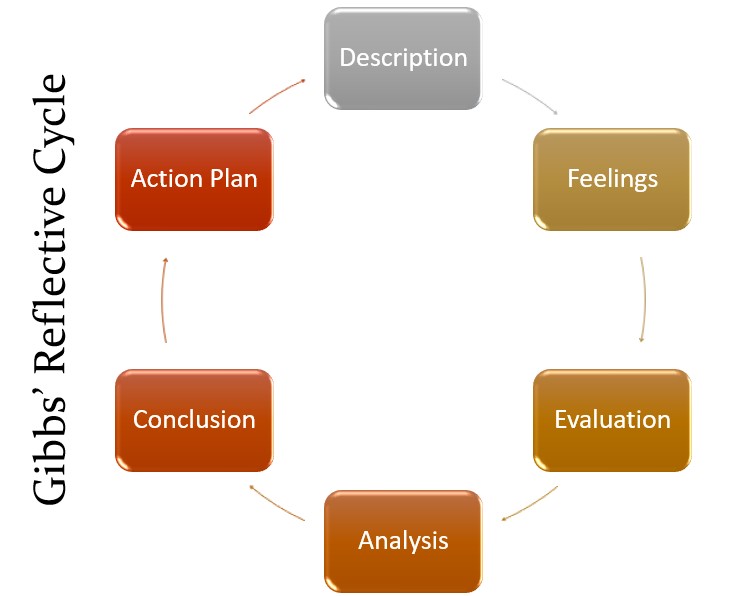Graham Gibbs, a professor at Oxford University in the United Kingdom, is known for his dedication to teaching and best learning practices. He has worked as the Director of the Learning Institute at Oxford, a professor at Oxford University and also created networking as well as collaborative initiatives across different organizations. Graham Gibbs retired in 2007.
In 1988, Gibbs published his work, Learning by Doing. This piece of work entailed his experiential learning theory, introduction to learning styles, practical methods to use the experiential learning cycle and case studies. He further expounded ways in which educators could implement the experiential learning methodologies.
The overall goal of the Reflective Cycle is to encourage learners to deeply reflect or look at their learning experiences in a systematic methodology to create more developed learning. This can be accomplished by evaluating a formal learning experience within a classroom, a situation, or even evaluating an activity. This cycle offers individuals an opportunity to deeply investigate an experience, delving into a reflective practice that promotes further learning.
Gibbs’ Reflective Cycle focuses on six steps or phases:
- Description
- Feelings
- Evaluation
- Analysis
- Conclusion
- Action Plan
These steps are cyclical in nature, encouraging the reflective learner to continue looking on the learning experience.

Description
This stage is exactly as it is called: simply a description of an event. Be sure to describe the event with as much detail as possible without including any conclusions or feelings as these will be addressed later.
- What happened?
- When did it happen?
- Where did it happen?
- Who else was there?
- Why were you there or others there?
- What did you do? What did others do?
- What was the end result?
- What did you hope would happen?
It is helpful in this phase to think of the five W’s: who, why, where, what, when. Don’t worry about the ‘how’ yet.

Feelings
Feelings is the focus on this stage. You may wish to go back through the earlier questions and think about the feelings associated with each question. Try not to judge the emotions you had during the experience. Recall there are no bad or good feelings. They are simply feelings. The most important part of this stage is to look at how you are affected by your feelings and how these feelings effected your learning experience.
- How did you feel before the experience?
- How did you feel during the experience?
- How did you feel after the experience?
- How do you think others in the experience felt?
- What do you think others feel now that the experience is over?
- How do you feel about the experience now?
It can be important to think about the feelings you had prior to the experience as these feelings going into an experience can taint or alter the learning opportunity altogether.

Evaluation
Now, you can really start judging the experience. But even though you are judging and evaluating the experience, it is essential to continue to be objective. Subjectivity and being overly critical will not lead to the best reflective learning. Be honest. Look at both positive and negative aspects.
- What went well?
- What didn’t go well?
- Why did things do well or not go well?
- What was good or bad about the event?
- What did you contribute?
- What did others contribute?

Analysis
This is the phase where the collected information is starting to be pulled together. This is the opportunity to deeply understand what occurred and mold meaning. Be sure to look at different points of view during this phase.
- What sense can you make of the experience?
- What was really happening?
- Were others’ experiences similar to yours? Were they different than yours? Why?
- Why did things go well or not go well?
- What additional information, resources or knowledge can help in making sense of the situation?

Conclusions
In this step, conclusions will be developed and looked at. Summarize the learning experience from all of the inputs received while also looking at the strengths and weaknesses of the experience. Especially take a moment to emphasize how you can learn from this and what improvements can be made.
- What did you learn from this experience?
- How could this experience be more positive? Be more negative?
- What skills could be developed to make the experience of greater value?
- What else could be done to enhance learning and productivity?
- What can be taken away from this experience?
- What can be specifically concluded about your personal learning or working within the situation?

Action Plan
This is the final step of Gibbs’ Reflective Cycle, but the cycle doesn’t have to stop here. If you feel there is more to learn, go back to step one and repeat.
Within this phase, take time to record how you could change the experience or what you could do differently to improve the situation. This is a time to make goals or resolutions toward change.
- What are you going to do differently next time?
- What steps can you take to ensure different consequences or outcomes?
- What skills or knowledge do you need to develop?
- How can you ensure different consequences or results next time?
Gibbs’ Reflective Cycle is a phenomenal methodology to reflect on learning experiences but certainly does not need to be restricted to a formal classroom. It can be used both for personal and professional venues. Also, take a moment to see how certain phases of this reflective cycle can be of more value than others in different circumstances.
Sources:
Gibbs, G. (1988). Learn by Doing. Available at: https://thoughtsmostlyaboutlearning.files.wordpress.com/2015/12/learning-by-doing-graham-gibbs.pdf



Comments are closed